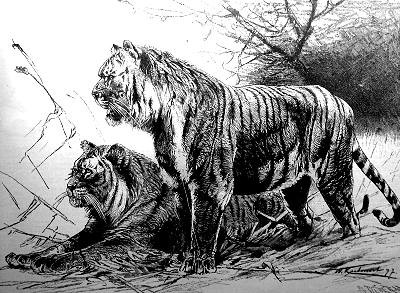Cousins of extinct giant Caspian tigers could thrive again in Central Asia
A site in Kazakhstan appears conducive to the re-introduction of Amur tigers in Central Asia.
A subspecies of tigers related to the extinct Caspian tiger could be reintroduced in Central Asia, scientists have said. They have identified a region of Kazakhstan that could potentially support a population of nearly a hundred tigers within the next five decades.
The Caspian tiger was once one of the world's largest felines. It prowled around in Afghanistan, Iran, Turkey, Mongolia, and the Central Asiatic area of Russia, but went extinct in the mid 1990s.
This subspecies of tigers particularly suffered from habitat loss in the former Soviet Union due to the launch of large irrigation and agricultural conversion projects across central Asia, which led to the destruction of tugay woodlands and reed thickets that formed the basis of the tigers' habitat. Their prey stock was also depleted by human activity and many were killed off by hunters.
"Sadly, many of the factors leading to the extinction of the Caspian tiger continue to blight the tiger today: habitat loss, lack of prey and hunting. ", Gabriel Fava, Associate Director for Asia and Oceania at the Born Free Foundation told IBTimes UK.
Ever since Caspian tigers disappeared, biologists and conservationists have tried to come up with a strategy to bring tigers back to Central Asia. The breakdown of the Soviet Union and advances in the field of phylogenetics have led to some progress - researchers have discovered that another tiger subspecies known as the Amur tiger is genetically very similar to the Caspian tiger and could potentially survive in Central Asia.
"In 2010-2012, scientists conducted studies that showed that Caspian and Amur tigers were almost identical in their genetic structure", said Mikhail Paltsyn, the author of a new study on the topic, published in the journal Biological Conservation.

For the last ten years, scientists have therefore discussed this idea of reintroducing tigers in Central Asia using Amur tigers from the Russian Far East as an 'analog' species. Paltsyn and his colleagues have reviewed scientific literature published about Caspian tigers to assess the feasibility of such a programme and have identified a site in Kazakhstan where Amur tigers could potentially thrive.
Finding the perfect site
The team's analysis of past studies focusing on Caspian tigers revealed that the animals historically occupied a territory as large as 800,000–900,000 km2, mostly within isolated patches of tugay-dominated landscapes. Density was roughly 2 to 3 tigers per 100 km2.
"To thrive, tigers need to be protected on the ground from poaching, and they need intact habitat, an adequate water supply and abundant prey. Given those conditions, they are prolific breeders and if left alone, will quickly populate an area", Fava explained.

Finding a site that meets all these conditions to successfully introduce Amur tigers is a challenge. The study's authors say they have identified two habitat patches in Kazakhstan that could be suitable for tiger re-establishment.
The most promising site is located in the Ili river delta, and adjacent southern coast of Balkhash Lake—in southeastern Kazakhstan. Taking into account tigers' habitat and prey needs, the researchers estimate that 7000 km2 of suitable habitat are available in this region.
The scientists modelled what would happen to tigers there, under different environmental scenarios and found that this area could support a population of 64–98 tigers within 50 years.
However, many obstacles could stand in the way of a successful reintroduction of Amur tigers. Hostility from local communities is possible, and their concerns will have to be addressed if tigers are to be well protected.
Prey population restoration will have to precede the introduction of tigers and the river's water supplies will have to remain stable for the animals to survive, reproduce and thrive.
"It is clear that when people talk of a potential reintroduction site from an area where they have been absent for many years, such an undertaking is in practice a long way off", Fava said.
"In maintaining healthy tiger populations, working with local communities is crucial, raising awareness of tigers' role and importance and working with them to develop the use of alternative sources of energy in order to protect tiger habitat. However, in countries that have not seen tigers for decades, although equally crucial, you're starting from scratch, so we're talking about a very different kind of effort".
Finally, it remains to be seen whether Amur tigers are well adapted to live in Kazakhstan's climate. Although they are closely related to Caspian tigers, it is possible that they are less suited to live in the region. "Our study brings the scientific foundations to start a reintroduction programme in Kazakhstan, but we will have to reintroduce the tigers progressively and monitor if they adapt well to the climate. And before anything happens, we will have to work with the authorities, policy makers and conservationists in the region, for the next five to ten to fifteen year, to make sure the conditions to reintroduce tigers in Central Asia are met", Paltsyn concluded.
© Copyright IBTimes 2025. All rights reserved.






















